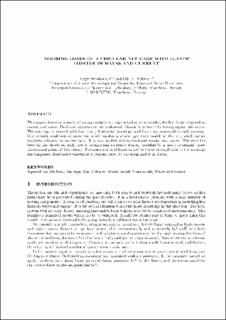| dc.description.abstract | The mooring loads on an aquaculture net cage in current and waves are investigated by dedicated model tests and numerical simulations. The main purpose is to investigate which physical effects are dominant for mooring loads, and in this respect, to investigate the validity of different rational hydrodynamic load models. Also structural and numerical aspects are investigated. The model tests are performed to provide benchmark data, while the numerical model is used to study the effect and sensitivity of different load models and parameters.
Compared to a realistic aquaculture plant, the total system is simplified to reduce the complexity. The system does, however, include all the four main components of an aquaculture plant: net cage, floater, sinker weights and moorings. The net cage is bottomless, flexible and circular. It is attached to a circular, elastic floater at the top and has 16 sinker weights at the bottom. The system is nearly linearly moored with four crow feet mooring lines.
The loads are measured in the four mooring lines. A systematic variation of current only, wave only as well as combined current and wave conditions is carried out. The numerical simulation results are first benchmarked towards the experimental data. The mean loads in general dominate over the dynamic part of the loads in combined current and waves, and they significantly increase in long and steep waves, relative to current only. Next, a sensitivity study is carried out. A rigid floater significantly alters the loads in the mooring lines compared to a realistic, elastic floater. The theoretical model for the wave matters. The mooring loads are rather insensitive to a majority of the parameters and models, in particular: frequency dependent added mass of the floater and nonlinear restoring loads. It seems not to be necessary to represent the net cage with a very fine numerical mesh. | en_US |
